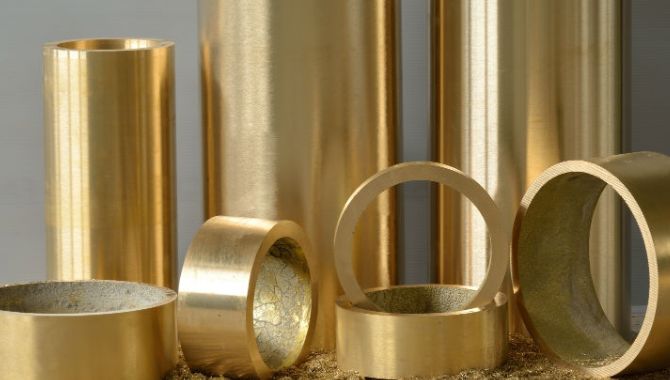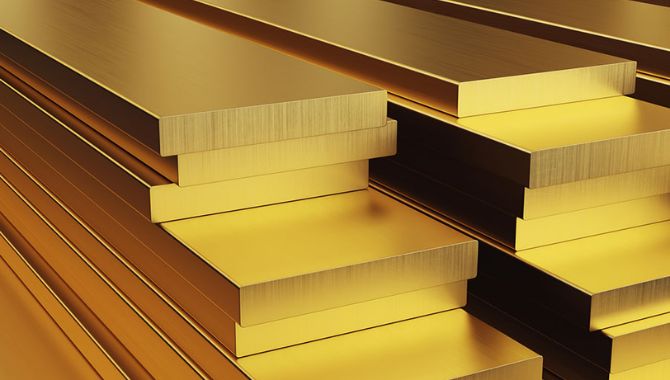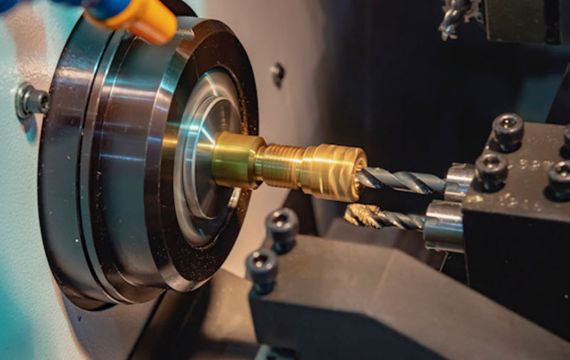Do You Want to Know What is Brass Made of? This Article Will Help You!
The material brass appears shining and golden. Brass is primarily composed of two metals: zinc and copper. It’s an extremely adaptable material, since the exact quantity of these two components may be changed in order to produce a variety of brasses with different qualities.
When zinc is added, brasses are typically tougher and more silvery; when copper is added, brasses are typically softer and more golden.
Brass Properties
- In addition to seeming bright gold, brass can also have a reddish-gold or silvery-white color.
- Brass has higher malleability.
- The metal has minimal friction.
- It is good at transferring heat.
- Casting brass is simple.
- Low melting point in the alloy.
- When sparking is less likely, a soft metal like brass might be employed.
- Resistant to corrosion, notably galvanic corrosion brought on by seawater.
- There is nothing ferromagnetic in brass; recycling is easier.
- Good material to use in musical instruments when it comes to acoustics.


Brass in Different Types
Alpha Brasses
Alpha brasses include 28–33% zinc and 67–72% copper. Because of their pliability, they are employed in pressing, forging, and other associated procedures.
Alpha-beta Brasses
Alpha-beta brasses are composed of 35–45% zinc and 55–65% copper. These brasses are appropriate for hot working; they are also referred to as duplex brasses.
Beta Brasses
Zinc and copper make up about 45–50% of beta brasses. Only hot work is possible with these brasses. In addition to being suitable for casting, they are stronger and tougher.
Gama Brasses
Gamma brasses are composed of 61–67% zinc and 33–39% copper. Gamma brasses containing Ag 30–50% and Au 41%, respectively, are also available.
Typical Grade of Brass
Alloy 260: Cartridge brass is one name for alloy 260. This brass alloy, which is roughly 70% copper and 30% zinc, has impurities.
Alloy 280: Alloy 280 is composed of roughly 60% copper, 40% zinc, and a negligible amount of iron, which is known as muntz metal.
Alloy 360: Alloy 360 is composed primarily of copper (around 60%), zinc (35.5%), lead (up to 3%), and iron (in trace amounts), which is known as free-machining brass.
Alloy 385: Architectural bronze, or alloy 385, is mostly made up of 42% zinc, up to 3.5% lead, and about 59% copper.
Alloy 464: Another name for alloy 464 is naval brass. This brass alloy consists primarily of 59% copper, 1% tin, and 40% zinc, with a trace amount of lead.

Brass Application


Plumbing Appliances and Parts
- Couplings, water heaters, pumps, valves, and pipelines.
Electronics and Telecommunication
- Printed circuit boards, shielding, condensers, connectors, switches, and jacks.
Equipment for Transportation
- Items found in cars, trains, and airplanes include hardware, fasteners, trim, radiator parts, door handles, and instrumentation.
Instruments for Music
- Bugles, saxophones, trumpets, trombones, tubas, and French horns.
Bearings & Bushings
- Brasses are appropriate for mildly loaded bushings and bearings that require long-lasting corrosion resistance.
Decorative Components
- Door knockers, paperweights, chandeliers, vases, candles, and statues.
Watercraft Equipment
- Seagoing boats and equipment consist of navy brass and seawater for their propellers, pumps, valves, condensers, fasteners, and gear.
Design Architecture
- Stairwells, artwork, door handles, railings, statues, and kick plates.
Process Technologies that Manufacturing Brass


- Casting: Melting brass and pouring it into a mold to form it into a desired shape is called brass casting.
- Extrusion: Extrusion is a procedure that forms brass into long, continuous shapes like tubes, rods, or profiles by forcing it through a die while heated.
- Forging: Heating the metal until it becomes pliable and then using force to form it is known as brass forging.
- Stamping: In order to cut and shape brass sheets into the required shapes, a press and dies are used in the process of brass stamping.
- Machining: Due to its exceptional machinability, turning, drilling, milling, and cutting operations can be completed with ease while working with brass.
- Rolling: To lower the thickness of the metal and form sheets or strips, brass rolling is the process of running the metal through a succession of rollers.
- Drawing: To make tubes, wires, or other extended shapes, the drawing process entails dragging metal through one or more dies.
- Deep Drawing: A sequence of dies is used in the deep drawing technique to gradually mold a brass sheet into a three-dimensional object.
- Spinning: A brass disc is formed over a mold or form by means of rollers or other tools while it is being spun at a high speed.
- Electroplating: Through the use of an electrochemical procedure, a thin layer of brass is electroplated onto another metal, typically steel or iron.
- Brazing: A filler material with a lower melting point than the metals being connected, usually brass, is used to unite two metals in the brazing process.
- Powder Metallurgy: In powder metallurgy, brass powder is heated to a temperature below its melting point after being compressed into the required shape.
- 3D Printing: A new process called additive manufacturing, or 3D printing, allows for the layer-by-layer deposition of material to create intricate brass components.
- Wire EDM: With wire EDM, a non-traditional machining technique, brass, and other conductive materials may be precisely cut using electrical discharges.
- Laser Cutting: Using a focused laser beam, brass sheets can be precisely and accurately cut into the appropriate forms using a non-contact method called laser cutting.
- Waterjet Cutting: Utilizing a high-pressure water stream combined with abrasive particles, waterjet cutting is an additional non-contact method that is used to cut metal such as brass.
Brass Advantages and Disadvantages

High Corrosion Resistance: In the presence of air, brass creates a shielding oxide layer that stops more corrosion.
Reduced Friction: Brass has a very low coefficient of friction.
Good Castability and Machinability: Casting, stamping, grinding, and polishing brass is a simple process.
Attractive Appearance: For ornamental architectural features, artistic creations, musical instruments, and consumer goods, brass offers a brilliant gold metallic appearance.
Antibacterial: Naturally antibacterial copper is a component of brass alloys.
Recyclable: Brass scrap metal is a valuable product that may be recycled extensively. The majority of brass is infinitely remeltable and reformable.

Heavy: Brass alloys are denser than the majority of commercial metals.
Prone to Tarnishing: Brass can tarnish to a black color from oxidation if it is not properly cared for.
Non-Hypoallergic: The copper or zinc component of brass, if improperly covered with a lacquer coating, may irritate skin in those with sensitive skin.
Hazardous Zinc Oxide Fumes: Zinc oxide can produce hazardous vapors; thus, workers should wear ventilation protection when melting and handling hot brass.
Non-sparking: Never use brass where there’s a chance of sparks igniting explosive gases or chemicals.
- Brass vs Bronze
| Brass | Bronze | |
| Composition |
|
|
| Color |
|
|
| Properties |
|
|
| Melting Point |
|
|
How Is Brass Produced?
- The nearly pure copper was extracted into copper metal by mining and processing.
- Brass is achieved by heating the refined copper and zinc metals to melting temperatures of 1083°C and 419°C.
- Molten metals are fully mixed in specified copper-to-zinc ratios.
- To form the molten brass into bars, ingots, or other shapes, it is poured into molds.
- The strength, hardness, and surface quality of extruded brass are frequently enhanced by processing methods.
- Lead, tin, aluminum, or manganese may be included in the composition of the finished brass alloy.
- The finished brass product is now prepared for production after being treated and cooled.
Can Brass Be Used Safely?
Common technical applications can safely use brass. It is therefore not advisable to come into contact with acidic food. Note that several microscopic organic species are seriously endangered by brass.
Those with sensitive skin may also experience adverse responses from it.
Brass or Bronze: Which Is Cheaper?
Bronze costs more money than brass. This is so because copper is found in bronze and zinc is found in brass. Generally speaking, zinc is less costly than copper.
How Much Does Brass Price?
Like most other metals, the value of brass can go up or down at any time. As of 2021:
- The brass pound value is 1.76 dollars.
- The brass scrap value is 1.74 dollars.
Does Brass Not Corrode?
Indeed, brass is renowned for being resistant to corrosion. Its surface develops an oxide layer of protection that aids in preventing rust and other types of corrosion.
Could Brass Be Magnetic?
No, brass is not magnetic. The alloy loses some of its magnetic characteristics when zinc is added to copper.
Is It Possible to Recycle Brass?
Brass is recyclable to a great extent. An energy-efficient method that contributes to resource conservation is recycling brass.
When Used Outside, Is Brass Appropriate?
Yes, because brass doesn’t corrode easily, it’s frequently utilized outside.
On the other hand, prolonged exposure to inclement weather can cause minor tarnishing.
What is the Environmental Impact of Brass?
Brass is eco-friendly because it is a recyclable material.
When compared to primary brass production, recycling brass lowers energy usage and contributes to resource conservation.



